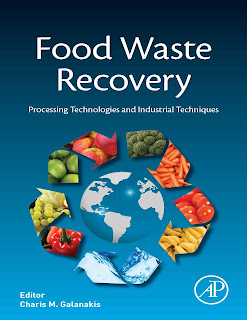“There is no doubt that with rising populations, food wastage is of ever growing significance. We are now at a point that it is no longer sufficient to simply reduce the amount of industrial or supply chain waste, whether agricultural or processing by-product, but to eliminate it. To achieve such targets, the inherent value; nutritional or functional, must be recovered from any waste stream. This requires a deep knowledge of the potential of such waste material, which in turn can drive the innovation process to realise that value. Food Waste Recovery edited by Dr. Charis Galankis provides the detailed insight needed to address these challenges head on. With detailed reviews of food wastage sources, potential value of waste streams and the traditional, innovative and emerging extraction and recovery technology, this book achieves the editors vision of producing an essential reference tool for food and drink professionals tackling the increasingly important issue of food waste.” -- Steve Osborn B.Sc. (hons), M.Phil., C.SCI., FIFST, Principal consultant - Food and Beverage, The Aurora Ceres Partnership Ltd.
"This book successfully captures the current outlook with regard to food waste valorisation, compiling the collaborative contributions of academic institutions and commercial organisations. Encompassing a breadth of separation and extraction technologies, both conventional and emerging, the book provides rich insight into the techniques which could either be employed in isolation or regarded as building blocks in a comprehensive biorefinery. Food Waste Recovery represents a much-needed toolkit, increasing the prospect of recovering high added-value compounds from organic byproducts. Moreover, it serves as a bridge between academia and industry, a vital handbook for anyone wanting to develop a food waste recovery application. Crucially, the book places priority on the ethical responsibility to maximise the efficient recovery of bioresources against the backdrop of ever-increasing pressure on natural resources due to climate change and rising populations. Thus, food waste valorisation is presented not simply as a commercial teaser; rather it is regarded as a vital activity as part of a coordinated strategy to ensure a sustainable food supply. Fundamentally, Dr. Galanakis has succeeded in drawing together accounts of the key technologies which will form the basis of any future biorefinery and this compilation marks a milestone in the journey towards that destination." -- Andrew Gadd, Link2Energy - Industrial Symbiosis Services - Medium
"There were times in human history where we had no access to information because it was unavailable. Now, we have an overload of information and it is a time taking process for each of us to identify our sources. This book makes it easier for those who are looking for the latest latest information and knowledge on processing food wastes in industrial settings. The book has expanded my knowledge about the variety of chemicals that can be recovered from food wastes and their final markets. Chapter 4, The Universal Recovery Strategy provides a good framework for approaching value recovery out of food waste. The framework can also be applied to recovery of food and organic waste in cities. This strategy will be more valuable when it is adopted widely, and researchers and decision makers expand on it according to their requirements. Given my background in engineering and consulting, I found Chapter 14 especially useful. It lays out the cost and safety issues of emerging and conventional technologies, which can be a good starting point for further research and decision making." -- Ranjith Annepu, Co-Founder, be Waste Wise, New York City
"The Food Waste Recovery book is a very complete overview on the possibilities for food waste use, focusing specially on added value products. The information provided in the book is very well organized and offers a comprehensive access to the information scattered in many technical and scientific publications. The books makes easy to find the potential of a specific waste or how to recover a molecule of economic interest with different technologies.
The book opens with an interesting introduction on valorization and the sustainability of the food industry and the valorization as alternative to other common food waste disposals or low-value recovery processes. The second chapter deals with the list of different by-products, potential added value molecules to be extracted and recovery alternatives. The book is very illustrative with many examples, graphs and scientific cites, making the search of literature on an specific product or technology much easier. It is especially interesting the description of the five stage universal recovery strategy in order to assess the technical and economic feasibility of the recovery.
Section II presents a wide range of traditional recovery pre-treatment technologies such as milling, thermal and vacuum concentration, evaporation, freezing, membrane separation, among others and the extraction technologies, like ultrafiltration, isoelectric precipitation, extrusion, use of solvents, nanofitration, etc. are described. Also state-of-the-art technologies like microwave and supercritical fluid extraction are mentioned including the advantages of the technologies with the economic implications when scaling-up. Examples of applications of these technologies in the food industry are also provided. Chapter eight describes an interesting range of options for industrial use of the recovered products.
But one of the most innovative and interesting parts of the book is the one in Section III dedicated to emerging technologies such as radio-frequency drying, electroosmotic drying, the use of low temperature plasma, high hydrostatic pressure, ultrasounds, pulsed electrical fields or magnetic fields and the applications and implementations in different food sectors beyond the applications at laboratory or pilot stages. Advantages and difficulties compared to the traditional techniques are described in detail. On the other hand, section IV provides very valuable information on the safety aspects and costs of the different recovery technologies so the food industry interested in recovering value added compounds can make calculations, therefore facilitating the decision in selecting the most convenient technology.
Definitely, the book is a “must have” for all those working with food waste recovery."
Aintzane Esturo - Technical Manager -PMP
SGF International e.V. I Sure – Global – Fair
Am Hahnenbusch 14b I 55268 Nieder-Olm I Germany



